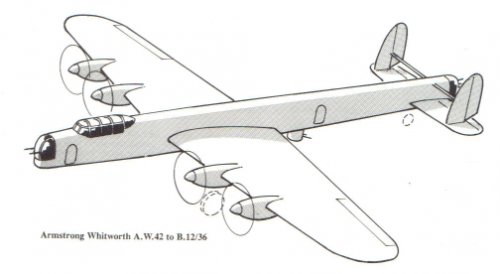British Secret Projects: Fighters and Bombers 1935-1950 Tony Buttler
A Design Tender Conference was held in October 1936 and the orders of merit put Vickers (Type 293) first followed by Boulton Paul, AWA, Supermarine and Short Brothers. Shorts’ project was described as ‘a robust effort but too near a flying boat design’. In the event, no immediate decision was taken on prototypes and the discussion continued for another three months. DTD recommend that, if Vickers was held up by Wellington production, Boulton Paul’s P.90 should be accepted which was ahead of the others in terms of easy manufacture.
The Shorts design was their original proposal, not the one we know was accepted while the Vickers Type 293 design employed geodetic construction.
Vickers Type 293
Span 100.0ft
Length 81.6ft
Wing area 1,290 sqft
Engines: 4 Kestrel (297mph at 17,000ft), Taurus (291mph at 17,000ft) or Dagger (297mph at 15,000ft) giving a ceiling 30,000ft – 33,000ft
Bombload: 30 250lb or 500lb bombs or 7 2,000lb
By January 1937 the Supermarine design was favoured and prototypes ordered but Shorts was encouraged to develop their original proposal as an insurance and this became the Stirling as we know it..
If The Vickers 293 had been the insurance aircraft, what does that do for Bomber Command’s and later on Coastal Command’s capabilities assuming the Type 293 replaces the Wellington?
A Design Tender Conference was held in October 1936 and the orders of merit put Vickers (Type 293) first followed by Boulton Paul, AWA, Supermarine and Short Brothers. Shorts’ project was described as ‘a robust effort but too near a flying boat design’. In the event, no immediate decision was taken on prototypes and the discussion continued for another three months. DTD recommend that, if Vickers was held up by Wellington production, Boulton Paul’s P.90 should be accepted which was ahead of the others in terms of easy manufacture.
The Shorts design was their original proposal, not the one we know was accepted while the Vickers Type 293 design employed geodetic construction.
Vickers Type 293
Span 100.0ft
Length 81.6ft
Wing area 1,290 sqft
Engines: 4 Kestrel (297mph at 17,000ft), Taurus (291mph at 17,000ft) or Dagger (297mph at 15,000ft) giving a ceiling 30,000ft – 33,000ft
Bombload: 30 250lb or 500lb bombs or 7 2,000lb
By January 1937 the Supermarine design was favoured and prototypes ordered but Shorts was encouraged to develop their original proposal as an insurance and this became the Stirling as we know it..
If The Vickers 293 had been the insurance aircraft, what does that do for Bomber Command’s and later on Coastal Command’s capabilities assuming the Type 293 replaces the Wellington?

